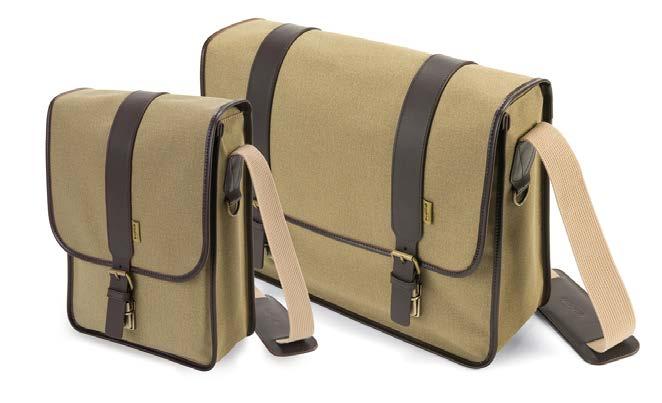
9 minute read
From development
by DICOTA
The mammoth Eco BASE project has been completed. An exciting look behind the scenes at the work of DICOTA’s international development team
Stephan Meyer, you have been with DICOTA for 18 years and are now one of the three owners of the group of companies. Please introduce yourself briefly.
With pleasure! I am 43 years old, a native of Würzburg, married and the proud father of two children. Since the management buyout in 2013, I have been responsible for product development and management, as well as for the supply chain as Chief Product Officer.
How were your first few months at DICOTA?
I gained some initial experience at DICOTA back in 2003 during an eight-month internship in product development in Hong Kong. The fascination with mobile carrying solutions, working with motivated teams, and within a dynamic corporate culture made me want to stay at DICOTA and move through different departments.
You lived and worked in Hong Kong for over ten years. Where do you see the biggest differences in European culture?
Certainly in terms of the speed and dimensions that underpin how new projects are initiated and implemented. The proximity to all stakeholders and the unwavering willingness to change allows us to create and implement solutions in the shortest possible time. Of course, it takes some time to recognise cultural differences. The famous practice of “reading between the lines” and adapting your way of communicating accordingly was a challenge in the beginning.
Hong Kong is considered a fascinating metropolis.
As a gateway to Asia – and especially China – the city’s history makes it unique. Hong Kong is vibrant, electrifying – and the possibilities seem limitless.
What is everyday life like in the development team in Hong Kong?
Our experienced team, with many long-standing specialists, works very intensively and in a process of permanent exchange. Every morning, for example, there is a “Sample Review Meeting” where designers,
project managers and product managers exchange ideas. Current design proposals are discussed, prototypes analysed, materials tested, and further potential for improvement evaluated. It is in our DNA to make good things better.
Back in 2012, you introduced the first notebook bag made of recycled PET (rPET) to the market – an innovation at the time. How did it come about? The development project had already been launched in 2011. As the market leader, we wanted to be the first with this outstanding innovation in the materials sector. Especially within the IT sector, sustainable materials were still unknown at that time. The choice
Concentrated development expertise on-site – the basis for innovation and quality f. l. t. r. Jessica Cheung, Louie Wai, Water Kwong, Sandy Lo, Paul Chow, Eric Tse, Joey Ho, Angela Lau, Cindy Wong
The metropolis with the most skyscrapers in the world – Hong Kong.
of fabrics was extremely limited. Before the launch, we carried out intensive material tests, because compromises in quality were (and are) not an option at DICOTA.
What has changed since 2012?
Today, customers are better-informed; and they possess a greater understanding of the importance of effective ecological action. The topic of sustainability has firmly
taken root in society’s conscience. With their purchase decisions, they choose as to whether they want a notebook bag made from traditional materials or from recycled, sustainable materials.
What are the differences with the ecologically sensible variant made of rPET when compared to traditional polyester?
The properties and performance of rPET are as good as the quality of new polyester. Both in terms of the visuals and the feel, there are no differences between the two fabrics. The subtleties, the textures, and the quality are absolutely on par. The production of rPET requires less energy than virgin polyester production and reduces our dependence on oil as a raw material.
What advantages do customers have when buying a computer bag made of PET?
Product life is one of them. We also provide a lifetime guarantee on our products. And shoppers make a significant contribution to reducing our ecological footprint by finding a second, sensible use for disposable bottles.
DICOTA currently offers over 60 products made of rPET. By the end of 2021, you want to produce more than 80% of the portfolio from the recycled material and have formulated sustainability as a central element of the company strategy. What are the reasons for this?
As an owner-managed company, we are fully aware of our responsibility for future generations and take this responsibility very seriously. Following the introduction of the SCALE and SELECT product families, the well-established BASE series is now being converted to rPET. This means that customers can also choose a more ecologically sensible solution in the entry-level price range.
With the products from the BASE series – the absolute top sellers in terms of volume – you are converting an existing series to rPET for the first time. Surely a challenging project for all employees?
The volume in this segment is considerable. But this is precisely why we can make a significant ecological difference here – including thanks to the loyalty of our DICOTA customers. For our team in Hong Kong, the changeover represented a real challenge in the areas of development, planning, and production. Excellent work was done here, with plenty of sweat and numerous overtime hours racked up. It’s

an extraordinary team effort and I am very proud of what we have achieved.
What changes from the customer’s point of view with the switch to Eco BASE?
Without doubt, the certainty that the tried-and-tested top sellers are now made of sustainable fabrics, thereby enabling the prudent secondary use of PET bottles. This is a real competitive advantage for our IT channel partners in their day-to-day and tender business. It is the basis for our direct and indirect customers to work with DICOTA as an innovative brand and reliable partner in the long term.
What influence does the product changeover have on online business?
It is important not to lose the successful history of BASE products in the digital world. This includes ratings, questions/answers, and, of course, customer feedback. That is why we are keeping the core of the article numbers, meaning that D30446 simply becomes D30446-RPET. This means that our partners and customers can still find the products easily. We also revised the product texts, produced new videos, and took new lifestyle pictures in a photoshoot.
What are you and your team up to next?
We are consistently pursuing our chosen path. The conversion to rPET will next take place in our flagship PRO series. The development work has already been completed. The introduction is scheduled for autumn 2021. In the next DICOTA Magazine, you will be able to read more on this. We also work on sustainable packaging solutions, material tests with biological materials and much more. As previously mentioned: we want to get better every day.
The interview was conducted by Jenny Müller, Product Marketing Manager.

Either – or: five questions for Stephan Meyer
Rice or pasta? Knife and fork or chop sticks? Mountains or sea? Bag or backpack? Polyester or rPET?
SUSTAINABILITY COMES FIRST
The specialists in the Product Management Team know that every detail counts and are aware of the importance of DICOTA’s strategic orientation.
FSC certified paper
From now on, the product tags will play their part in the respectful treatment of nature: The papers are FSC-certified, to ensure the sustainable and responsible use of forest resources.
Printing with soy ink
All product tags are printed with soy ink. Unlike conventional ink made from petroleum, soy-based ink is more environmentally-friendly and based on renewable raw materials. The quality of this sensible alternative is absolutely on par.
Recycled materials
The new Eco-Label from DICOTA guarantees that the product is made from recycled materials. At the same time, it represents a discreet statement highlighting a sustainably correct purchase decision.


Sustainable products –a success story
For over twelve years, DICOTA has been offering carrying solutions made from ecological materials.
2009 – that was just when...
Barack Obama became the 44th President of the USA, Michael Jackson died of a drug overdose, Jenson Button became Formula 1 World Champion, and Windows 7 was introduced worldwide. It feels like only yesterday, and yet it was a long time ago…
Starting signal with Luis Trenker optics
As a leading European brand, DICOTA launched the first products made of ecological materials in 2009. The designs themselves also broke new ground. The commercial success of the pilot project was rather modest, as the two products in the NATURE LIFE/ STYLE collection were not at the top of the IT managers’ shopping lists. In the trade press, as well as among end-users, however, the “green” innovation was received positively.
Initial spark for a sustainable orientation
Inspired by this feedback, DICOTA laid the founda- tion for its future direction. A complete product family made from recycled materials for professional users and a clear conceptual design that embraced the requirements of a business environment, as well as a classic design language. Launched in 2010 under the name RECLAIM, the ECO product family followed in 2014.
Already seven product families by the end of 2021
In 2021, the sixth and seventh product families made from recycled materials will be launched. This makes DICOTA the clear number one among providers of sustainable carrying solutions for laptops and the like.

NATURE LIFE/STYLE
Edition No. 1, market launch 2009
The PR release at the time read: “...Industry leader DICOTA is setting new trends in the Notebook bag market segment: Nature Style and Nature Life are made from environmentally neutral materials. They are made of canvas cotton and leather that are as robust as they are environmentally friendly...”. Two messenger bags with an alpine look pick up on the “green IT” trend of the 2000s. The response from customers was consistently positive. The use of sustainable materials was a done deal.
RECLAIM
Edition No. 2, market launch 2010
The findings from Edition No.1 have been incorporated into the new conception of RECLAIM. The focus was on the design: It was aimed at business users who appreciate both a classic appearance and who possess a clear-cut attitude to the topic of ecology. Positioned in the mid-entry segment in terms of price and function, discreet grey highlights made up the typical character of this series. 16 choices in various sizes and colours offered a wide rage of choice. In total, over 200,000 mobile users have opted for RECLAIM products – a great success story.

ECO
Edition No. 3, market launch 2014
Elated by the resounding success of its predecessor series RECLAIM, DICOTA introduced the next eleven-model product family made of rPET in 2014. Practical features – such as tablet and power supply compartments – enhanced the bags, backpacks, and trolleys. The practical, sustainable companions for the demanding, hectic everyday business life also enjoyed great popularity. They quickly became top sellers in the DICOTA portfolio – around 250,000 units are in use by customers.







